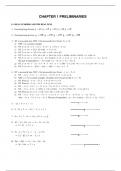Exam (elaborations)
Test Bank For Thomas calculus 11th edition solution manual All Chapters Included
- Module
- Institution
- Book
CHAPTER 1 PRELIMINARIES 1.1 REAL NUMBERS AND THE REAL LINE 1. Executing long division, 0.1, 0.2, 0.3, 0.8, 0.9 " 9 9 9 9 9 œ œ œ œ œ 2 3 8 9 2. Executing long division, 0.09, 0.18, 0.27, 0.81, 0. 11 " œ œ œ œ œ 2 3 9 11 3. NT = necessarily true, NNT = Not necessarily true. Given: 2 &l...
[Show more]




